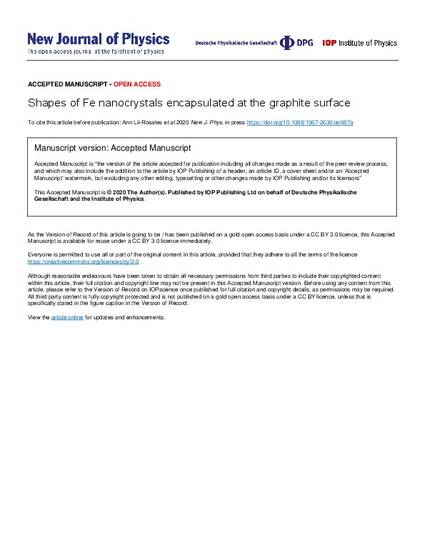
We describe and analyze in detail the shapes of Fe islands encapsulated under the top graphene layers in graphite. Shapes are interrogated using scanning tunneling microscopy. The main outputs of the shape analysis are the slope of the graphene membrane around the perimeter of the island, and the aspect ratio of the central metal cluster. Modeling primarily uses a continuum elasticity (CE) model. As input to the CE model, we use density functional theory to calculate the surface energy of Fe, and the adhesion energies between Fe and graphene or graphite. We use the shaft-loaded blister test (SLBT) model to provide independent stretching and bending strain energies in the graphene membrane. We also introduce a model for the elastic strain in which stretching and bending are treated simultaneously. Measured side slopes agree very well with the CE model, both qualitatively and quantitatively. The fit is optimal for a graphene membrane consisting of 2-3 graphene monolayers, in agreement with experiment. Analysis of contributions to total energy shows that the side slope depends only on the properties of graphene/graphite. This reflects delamination of the graphene membrane from the underlying graphite, caused by upward pressure from the growing metal cluster. This insight leads us to evaluate the delamination geometry in the context of two related, classic models that give analytic results for the slope of a delaminated membrane. One of these, the point-loaded circular blister test model, reasonably predicts the delamination geometry at the edge of an Fe island. The aspect ratio also agrees well with the CE model in the limit of large island size, but not for small islands. Previously, we had speculated that this discrepancy was due to lack of coupling between bending and stretching in the SLBT model, but the new modeling shows that this explanation is not viable.
Available at: http://works.bepress.com/patricia_thiel/173/

This article is published as Lii-Rosales, Ann, Yong Han, Scott E. Julien, Olivier Pierre-Louis, Dapeng Jing, Kai-Tak Wan, Michael C. Tringides, J. W. Evans, and Patricia A. Thiel. "Shapes of Fe nanocrystals encapsulated at the graphite surface." New Journal of Physics 22 (2020): 023016. DOI: 10.1088/1367-2630/ab687a. Posted with permission.